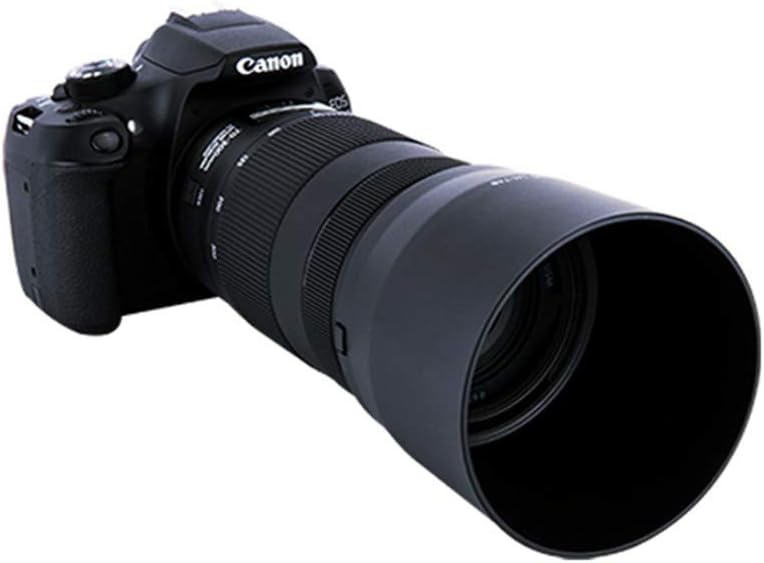Lens hoods are an essential accessory for most photographers. A lens hood serves to block unwanted light from entering the lens from the sides. This helps prevent lens flare and ghosting, which can occur when strong light sources hit the front element of a lens at an angle. Lens hoods essentially cast a shadow around the lens optics. This extra shading allows photographers to maintain maximum image quality even in very bright lighting conditions.

Lens Hood, ET-65 III Plastic Lens Hood Replacement for Canon EF 85mm F/1.8M SH Lens.
Most interchangeable lenses will come shipped with a lens hood designed specifically for that focal length. Photographers keep their lens hoods attached at all times except when a filter is mounted on the front of the lens, as filters can interfere with hood placement. Overall, lens hoods provide inexpensive protection for lens elements while improving contrast and sharpness.
Basic Information About Using a Lens Hood and Reasons When Not To
When to Use a Camera Lens Hood to Improve Your Shots
Lens hoods should always be used when shooting outdoors in bright light. The strong rays of the sun produce lens flare and ghosting if they hit the lens at an angle, degrading image quality. With a hood blocking these lateral light rays, contrast and sharpness are optimized even in high-contrast scenes. Lens hoods are also useful when light sources may be in frames edges that could cause glare, such as shooting towards a window.
They can help hide the lens from view to prevent unwanted reflections. Hoods are particularly beneficial for portraiture when the sun is behind the camera. They prevent harsh shadows on faces from internal lens element reflections.

18-55mm Lens Hood Shade for Canon EF-S 18-55mm f/3.5-5.6 is STM & RF 24-50mm f/4.5-6.3 is STM Lens Replaces Canon EW-63C Hood for Canon Rebel T8i T7i T7 T6i SL3 SL2 EOS R8 R10 R7 90D 80D 77D
When To Avoid The Use Of Lens Hood
There are some scenarios when you may not want to use your lens hood. For example, if you are squeezing your camera and lens into a very tight shooting space, the extended size of the hood could make it difficult to compose shots. Hoods can also cast unwanted shadows on your subject if the lighting is coming from directly in front of the camera.
Additionally, lens hoods tend to block some of the view in your camera’s viewfinder or LCD screen, making it harder to frame shots accurately. In situations with limited workspace or when working in dim indoor lighting, you may opt to take the hood off for improved visibility and maneuverability. But for most outdoor photography, keeping the hood mounted is recommended.
Types of Lens Hoods
There are three main types of lens hood designs:
- Petal hoods, also called tulip hoods, have flexible petals or tabs that expand and contract the hood opening to match the lens focal length. This makes them well-suited for zoom lenses with varying angles of view.
- Cylindrical hoods have a round tube-like shape designed for prime lenses with a fixed focal length. They provide uniform shade coverage along the lens barrel.
- Square hoods, as the name implies, have a square cross-section profile. They are often used for fisheye and ultra-wide lenses that have a very wide view typically greater than 180 degrees. The square design shades the maximum possible area around these lens types.
In general, petal hoods are best for zooms due to their adjustable design. Cylindrical hoods work well for standard prime lenses. And square hoods are ideal for lenses with super wide angles of view like fisheye lenses. Choosing the right type of lens hood depends on the lens you are using and its focal length capabilities.
Cylindrical lens hoods work by protecting your lens and blocking stray light. Petal lens hoods have four ‘petals’ so you can rotate it for optimum performance so you don’t get the lens in the frame. There is usually just one hood for each lens, where each is optimized for use with the lens’ focal range.

JJC LH-74B Reversible Lens Hood Shade for Canon EF 70-300mm f/4-5.6 IS II USM replaces Canon Lens Hood ET-74B with Button to Lock or Release.
Do lens hoods affect image quality?
When used properly, lens hoods do not negatively impact image quality and can often help improve it. By blocking unwanted light rays from entering the lens at steep angles, hoods reduce the chances of lens flare and ghosting occurring in bright lighting conditions. These optical artifacts have the potential to negatively affect image sharpness and contrast. With a lens hood shading the front element, photographers can retain maximum clarity even in very high-contrast scenes.
It’s possible for a lens hood to theoretically introduce vignetting or dark corners in an image if it is excessively large for the given lens. However, hoods are carefully designed and sized by manufacturers to avoid this. As long as the hood is not touching the image frame edges, it will have no unwanted shading effect. Some perceivable softening at the extreme corners is possible but typically very minor. Overall, by preventing issues like flare and ghosting from happening, lens hoods can enhance not degrade the quality of the final photo. Their shielding benefits usually outweigh any negligible optical downsides.
Lens Hood and Filters
Can I use lens hood with filter?
In most cases, it is possible to use a lens hood together with a filter mounted on the front of the lens. However, there are a few factors to consider. The filter must be the exact size of the lens’s filter thread diameter. Using a filter that is too small or large could damage the lens or filter threads.
It’s also important to check the compatibility of the filter and hood sizes. Large or protective filters may overlap with the hood opening and prevent it from properly shading the lens. In these situations, it may be necessary to remove the hood before attaching the filter.
Ensure the lens hood can still extend out far enough when the filter is mounted to provide adequate shade coverage. You want the hood rim to extend beyond the outer rim of the filter.
As long as the filter and hood sizes match and allow full extension of the hood, there generally are no issues photographically with using them together. The hood will still help reduce lens flare from the filter surface just as it does with no filter attached. Proper sizing is key for compatibility.

Sony Lens Hood for SEL70200GM – White – ALCSH145
What kind of lens hood is best?
There are a few different types of lens hoods available: plastic lens hoods, metal lens hoods, and universal snap-on lens hoods. In general, metal lens hoods provide better protection and likely last longer than plastic hoods. However, plastic hoods are lighter. A universal snap-on hood is convenient if you use different lenses as it can adapt to various lens sizes. For most lenses, a lens hood specifically made for your lens will work best as it is designed perfectly for the lens size and shape.









FAQ About Lens Hood
Should I use a lens hood on a cloudy day? While lens flares and glare are less of an issue on overcast days, it’s still a good idea to use a lens hood. Even on cloudy days, light can still cause lens flare issues from light bouncing around in the lens. A lens hood also helps protect the front element of the lens from accidental bumps and knocks.
Why not to use a lens hood? The only real downside to using a lens hood is the slight inconvenience of having to attach and detach it between shots. However, the protection it offers far outweighs this minor inconvenience. Just be sure not to leave the lens hood on when travelling as it could catch on things and damage the lens.
Is a lens hood better than a lens cover? While lens covers serve the purpose of protecting the front element of the lens when not in use, a lens hood has some advantages over a basic lens cover. A lens hood not only protects the front of the lens from accidental damage, but also helps reduce lens flare and ghosting caused by extraneous light entering the lens at awkward angles. Unlike a lens cap that must be attached and removed, a lens hood remains in place while shooting. For active shooting situations, a lens hood allows viewing through the lens while providing protection. So in most cases, a lens hood is a better choice than just a lens cap alone.
What is the difference between circular and square lens hoods? The most common type is a circular lens hood, as it mimics the barrel shape of most lenses. Circular hoods help block light entering from the sides in a full 360 degrees around the lens. Square hoods, on the other hand, only provide shade on the four sides but not fully around. They are generally less effective than circular hoods at blocking stray light. However, square hoods can fit into tighter spaces compared to barrel-shaped circular ones. Some lenses also come with angular hoods that are triangular or rectangular in shape.
Should I use a lens hood indoors? While lens flares and glare from outdoor light sources are less of an issue indoors, it’s still a good idea to use a lens hood when possible. Lens hoods help protect the front element of the lens from accidental bumps or scrapes, which is especially useful in less controlled indoor environments. The hood’s extra shading can also reduce extraneous reflections bouncing around inside the lens. However, indoor spaces often have limits that may make it inconvenient to use larger lens hoods. So weigh the protection benefit versus maneuverability needed for your indoor shots.
Do all lens hood fit all cameras? not all lens hoods are universally compatible with every camera system. Lens hoods are designed to fit specific lens mounts, diameters, and focal lengths. While universal lens hoods exist, they may not extend far enough or fit securely to block light from all angles, increasing the risk of flare. Using a lens hood precisely crafted for your exact lens ensures the best blocking of stray light while offering full protective coverage of the front element. For maximum performance benefits, it’s important to match the lens hood to your specific camera and lens combination.
While universal hoods exist, it is best to match the specific hood to your lens for full effectiveness. Following the advice in this guide will help you utilize lens hoods optimally. So pick up your camera and hit that shutter button!!!!!

